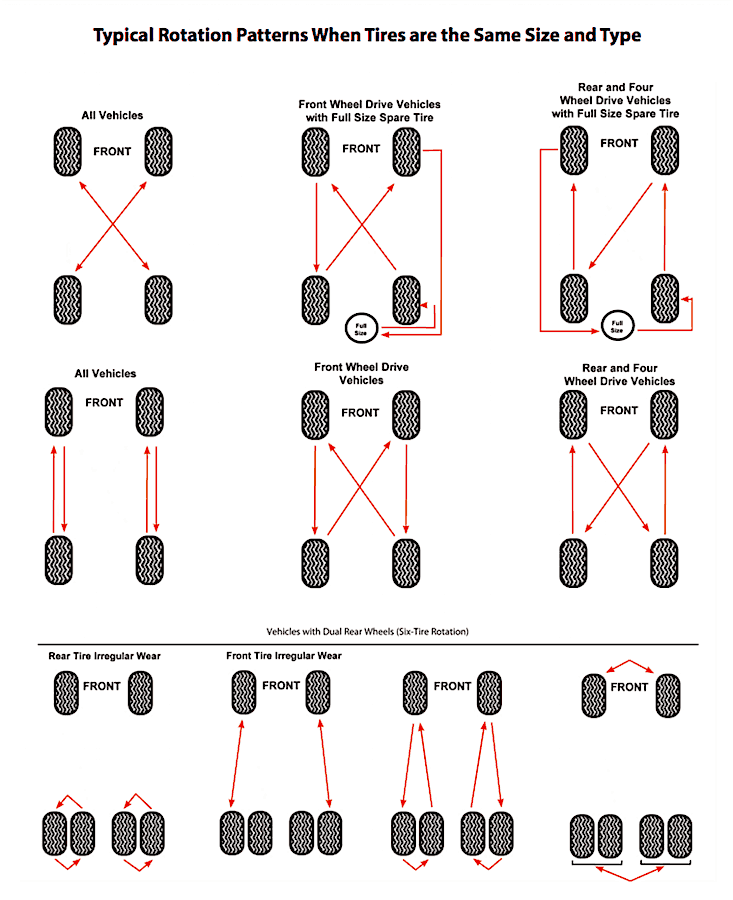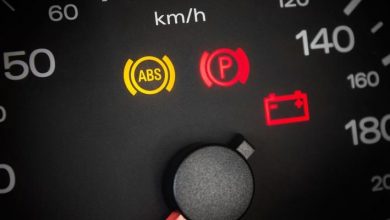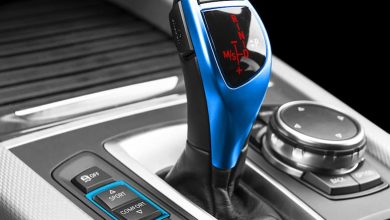
It might be time to rotate your tires. But why? And when is tire rotation a good idea? We provide a 6-step guide to swap your rubber yourself and touch on different tire rotation patterns and the costs.
One of the most manageable techniques for getting the most out of your tires — something you can do at home, too — is tire rotation.
Rotating your tires is crucial to ensure their safe performance. Rotating the tires means that they switch their position on your car in a specific pattern. This should be done regularly or after every 8000 to 12,000 kilometres. Tire rotation, in this manner, maintains the tire’s driving safety as it is upkeep routinely. Furthermore, some tire makers require the tires to be rotated for them to be qualified for warranty.
In many parts of North America (and pretty much all of Canada unless you’re on the Vancouver coast), winter tires are a necessity. If you experience long periods of temperatures less than 45 F or 7C (yes, seven above zero) and or snow, you need winter tires. For many drivers, the changeover from winter to summer and back provides an excellent rotation schedule at the same time.
Tire rotation also gives you an opportunity to safely check your tires. When the tires are taken off your car, you or the mechanic should check them for any sign of damage, uneven wear and any problematic area should be remarked. If necessary, a damaged tire should be changed out for a new one to prevent their failure on the road.
Tire rotation extends the tire’s usability. Different applications on the vehicle put versatile pressure on the tires mounted there. To ensure their even and consistent wear on all tires mounted on the vehicle, the tires should be rotated. Not only will these tires wear in an identical manner, which lengthens the usability, it will also ensure the tires maintain traction and controllability. The identical wear on all tires optimizes the surface contact, which improves the surface gripping capacity. This also ensures the tires’ responsiveness and stability during their performance.
Tire rotation is especially crucial with all-wheel drive and four-wheel drive vehicles. These vehicles need all of their tires to have the same amount of tread left on them. If this is not the case, the different pressure affecting the tires will cause excess stress on the drivetrain, which can lead to vehicles requiring some costly repairs.
There, tire rotation is crucial for the continued use of the tires and it even helps protect you and your vehicle.
Just remember, Your tires are the only things holding your car on the road, and they do that with a combined contact patch of about the size of a standard brochure cover.
How to Rotate Your Tires
Here’s our quick guide below. Digital Trends also has a comprehensive piece here on how to rotate tires.

Recommended tools:
- car jack (the one supplied with the car will do)
- jack stand
- torque wrench with appropriate-sized socket
- tire iron
- air compressor
- wheel chocks
- wheel lock key (if you have wheel locking nuts)
Step-by-Step Tire Rotation Guide:
1. Read the owner’s manual
This will tell you the recommended rotation pattern, which depends on the drive layout (front-drive, rear-drive, all-wheel drive) of your vehicle, as well as whether your vehicle employs directional tires. Directional tires are only supposed to be mounted to rotate in the direction of the forwarding movement.
2. Find the spare tire
If your vehicle uses a full-size spare — in other words, it’s the same size and make of tire, mounted on wheels identical to the other four and is not marked “for temporary use only” — take it out of the trunk and place it near the rear, passenger-side wheel.
3. Check all wheels for tire pressure
Check all wheels for tire pressure, including the spare. Top up or deflate slightly any that are off-spec. (The correct pressures are listed in the manual and on a placard on the driver’s side door jamb.)
4. Chock the other wheels and apply the brake.
Loosen the rear passenger lug nuts but do not remove them. Using the car’s jack and recommended jacking points (again, in the manual), lift the car at the rear passenger wheel until it’s off the ground. Completely remove the lug nuts and take off the wheel. Replace it with the spare tire.
5. Got a full-size spare?
If your vehicle employs a full-size spare, replace the wheel just removed with the spare. Move the removed wheel to near its recommended rotation partner (see below). If your vehicle uses a temporary spare, place a jack stand in the recommended location at the passenger rear wheel and lower the vehicle onto the stand.
6. Rinse and repeat
Move to the removed wheel’s partner and repeat the process to loosen, jack and remove that wheel. Continue following the rotation pattern until you’re ready to replace the rear passenger wheel that you started with. If your full-size spare is already in that location, place the last tire in whatever location holds the spare tire in your vehicle.
Reinstalling wheels
Place the wheel on the wheel bolts and double-check it’s facing the right way, and if directional, the rotation direction is to the front of the car (clockwise on right-side wheels, counterclockwise on the left). Replace the lug nuts and snug them by hand. Lower the tire to the ground.
Now, starting with any particular lug nut, tighten that nut and then make the last tighten with a torque wrench to the recommended torque. (Torque specifications change from vehicle to vehicle and in this case, an internet search engine is your friend.)
Next, move to a lug nut opposite the first and tighten it. In the case of a four-bolt pattern, move to the nut at the opposite corner. If a five-bolt pattern, move to a nut two away from the first, in either direction. Repeat crossing over until all nuts are tight.
The next day, re-torque the nuts again. Metal relaxes after the first tighten and can leave nuts loose.
Tire Rotation Pattern
If your vehicle uses directional tires, the pattern is simple: back tires move to the front and front to the back, without crossing sides.
If your vehicle uses different sizes on the front and rear, there’s also a good chance it uses directional tires. In this case, you need a shop, as the tires need to be dismounted and remounted on their corresponding partner’s wheel. (Front right goes to front left, rear right goes to rear left.)
There’s a chance you have different sizes front and back but not directional tires. This staggered placement means you can swap rears and fronts side-to-side without dismounting and remounting.
If your vehicle does not use directional tires, move the rear tires to the opposite side at the front and the front tires to the opposite side at the rear.
If your vehicle uses a full-size spare — meaning it’s the same size and mounted on a wheel identical to the others — put the spare on the right passenger side and put the front driver’s side wheel in the spare-tire location.
Tire Rotation Costs
The cost will depend on your local shop’s rate, as it’s primarily a service that requires no parts. Dardoor Auto has a discussion here on how much tire rotation should cost with varied price points.
Look for rates between $50 and $80, more if your tires are staggered and directional and must be dismounted and remounted. Blend rotation into the summer-winter changeover to save some money.








